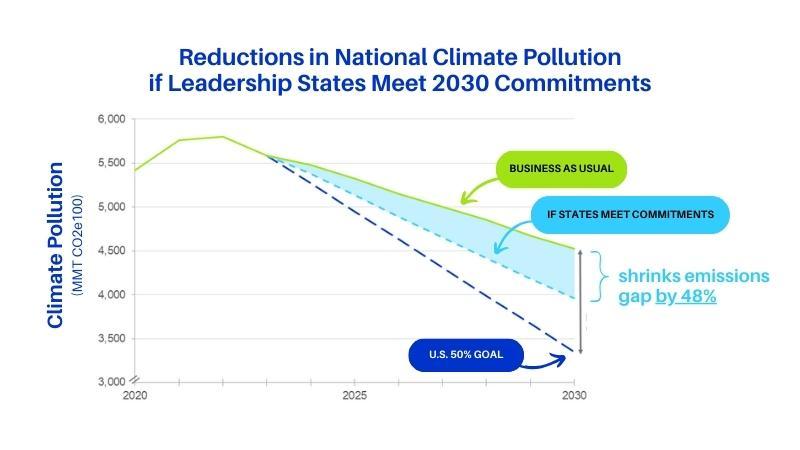Analysis: If Leading Governors Turn Climate Pledges into Policy, States Can Shrink U.S. Emissions Gap to Paris Target in Half
New emissions analysis, which uses 2023 projections from Rhodium Group, assesses the collective impact that U.S. states with climate commitments could have and how far they need to go to reach their own targets.
(DUBAI – December 5, 2023) Today at COP28, EDF shared new analysis which finds that leading governors have a pivotal role to play in getting the U.S. closer to its 2030 NDC, with the ability to cut the remaining distance to the U.S. commitment under the Paris Agreement in half. Using the latest U.S. emissions projections from leading modeling firm Rhodium Group, the analysis finds that if leading states were to meet their climate commitments, they would shrink the nation’s remaining “emissions gap” — the distance between projected emissions under current policies and the U.S. 2030 NDC — by 48%.
This finding builds on recent analyses from the Princeton-led REPEAT project, BloombergNEF, The U.S. Department of Energy, and more, which all show that while U.S. emissions should fall significantly this decade with swift implementation of federal clean energy investments, models still project a remaining gap to the country’s goal to slash emissions 50-52% by 2030.
To help shrink that gap, the analysis shows that leading states must rapidly pick up the pace on turning pledges into policies that limit climate pollution. On their current path without additional policy action, these 25 states and territories are collectively projected to reduce emissions by only 19% below 2005 levels by 2025 and 31% below 2005 levels by 2030 (under a central emissions scenario), well short of their commitments to reach at least a 26% reduction by 2025 and at least 50% by 2030.
“The U.S. can’t achieve its vital commitments under the Paris Agreement without strong follow-through from leading governors,” said Pam Kiely, Associate Vice President for U.S. Climate at Environmental Defense Fund. “This analysis makes clear that the climate action coming out of these state capitals matters to us all. Many of these governors have been in a position of climate leadership for years – it’s time for them to move beyond pledges and plans and hit the accelerator on policy that limits pollution in line with their goals. Flush with cash from federal clean energy investments, this is a golden opportunity for each state to adopt bold policies that slash health-harming air pollution, unleash jobs, lower energy costs, and help secure a safer climate future for us all. They can’t miss this moment.”

The report looks at U.S. states and territories that have committed to reduce their emissions in line with national goals, many of which first made those pledges more than 5 years ago. These 25 states and territories with commitments represent 43% of total U.S. emissions.
The analysis also estimates the impact on cumulative pollution if states were to stay on their current course. Because long-lived greenhouse gasses like carbon dioxide can remain in the atmosphere for centuries, the cumulative build-up of these emissions over time will determine the severity of climate damages. The analysis finds that, without further policy action, climate leadership states are projected to emit 29% more climate pollution between 2020 and 2030 than a path aligned with their science-based goals — overshooting the emissions “budget” by nearly 6 billion metric tons of CO2 equivalent.
To meet their climate commitments and make the most of new federal investments, EDF makes several policy recommendations for state leaders:
- Set binding targets that achieve early and deep reductions: Mandatory targets that create an enforceable framework are key for reducing emissions at the pace and scale the climate crisis demands. Without mandatory targets, climate action could be stalled or rolled back by future state leaders. To date, only 10 leadership states have established mandatory economy-wide climate targets in state law.
- Use existing authority to limit pollution: Regardless of state legislative action on climate solutions, governors committing to concrete pollution reduction targets can leverage existing authority to enact regulations that lower climate pollution.
- Establish a declining, enforceable limit on emissions: A pollution limit — like Washington state’s economy-wide cap on emissions — is essential to provide a backstop for other complementary policies, guaranteeing the targeted emission cuts will be achieved, even if other policies fall short. Limits can be source-specific, sectoral, or cover multiple sectors of the economy.
- Pair pollution limits with policies that catalyze development and deployment of clean technologies: Enforceable limits on climate pollution can work hand-in-hand with measures needed to accelerate clean technology deployment, like clean energy mandates and electric vehicle incentives, while providing the greatest possible certainty that states will reach their climate targets.
- Ensure environmental and economic benefits are directed to disproportionately-impacted communities: Strategies for limiting climate pollution must be tailored to improve local pollution impacts and directly support clean energy deployment and economic benefits for the most overburdened and underserved populations.
- Consider an approach that puts a price on pollution: By pairing an enforceable pollution limit with a price on pollution, as the Regional Greenhouse Gas Initiative does, states can secure the needed level of emission reductions, while creating a price signal that incentivizes investments in clean energy technologies.
Visit the report webpage for more information, including a report factsheet.
With more than 3 million members, Environmental Defense Fund creates transformational solutions to the most serious environmental problems. To do so, EDF links science, economics, law, and innovative private-sector partnerships to turn solutions into action. edf.org
Media Contact
Latest press releases
-
EU Methane Regulation Emerges As Strategic Tool For Energy Security
December 10, 2025 -
Court Strikes Down Trump Administration’s Reckless Wind Energy Permitting Ban
December 8, 2025 -
Court Orders Trump Administration to Release Records of Secret Group That Wrote Report Attacking Climate Science
December 8, 2025 -
COMING SOON: An effort to weaken our popular chemical safety law
December 8, 2025 -
Groups File Lawsuit Challenging Trump EPA Final Rule That Delays Methane Pollution Protections from Oil and Gas Industry
December 4, 2025 -
New Statewide Survey: As Electricity Demand and Costs Skyrocket, Arizonans Support Building More Wind and Solar Energy
December 4, 2025











